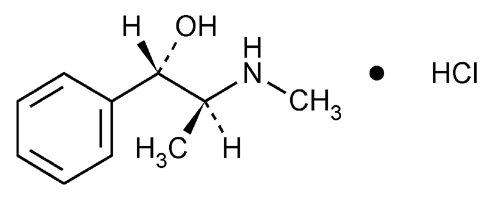Pseudoephedrine Hydrochloride
Benzenemethanol,
(+)-Pseudoephedrine hydrochloride
» Pseudoephedrine Hydrochloride contains not less than 98.0 percent and not more than 100.5 percent of C10H15NO·HCl, calculated on the dried basis.
Packaging and storage—
Preserve in tight, light-resistant containers.
Melting range, Class I  741
741 :
between 182
:
between 182 and 186
and 186 , but the range between beginning and end of melting does not exceed 2
, but the range between beginning and end of melting does not exceed 2 .
.
pH  791
791 :
between 4.6 and 6.0, in a solution (1 in 20).
:
between 4.6 and 6.0, in a solution (1 in 20).
Loss on drying  731
731 —
Dry it at 105
—
Dry it at 105 for 3 hours: it loses not more than 0.5% of its weight.
for 3 hours: it loses not more than 0.5% of its weight.
Residue on ignition  281
281 :
not more than 0.1%.
:
not more than 0.1%.
Change to read:
Ordinary impurities
Test solution:
alcohol.
Standard solution:
alcohol.
Eluant:
 A mixture of isopropyl alcohol, ammonium hydroxide, and chloroform (80:15:5).
A mixture of isopropyl alcohol, ammonium hydroxide, and chloroform (80:15:5). USP32
USP32
Visualization—
 1, followed by 4.
1, followed by 4. USP32
USP32
Assay—
Dissolve about 400 mg of Pseudoephedrine Hydrochloride, accurately weighed, in a mixture of 50 mL of glacial acetic acid and 10 mL of mercuric acetate TS, add 1 drop of crystal violet TS, and titrate with 0.1 N perchloric acid VS to a blue-green endpoint. Perform a blank determination, and make any necessary correction. Each mL of 0.1 N perchloric acid is equivalent to 20.17 mg of C10H15NO·HCl.
Auxiliary Information—
Please check for your question in the FAQs before contacting USP.
Chromatographic Column—
| Topic/Question | Contact | Expert Committee |
| Monograph | Clydewyn M. Anthony, Ph.D.
Scientist 1-301-816-8139 |
(MDCCA05) Monograph Development-Cough Cold and Analgesics |
| Reference Standards | Lili Wang, Technical Services Scientist 1-301-816-8129 RSTech@usp.org |
USP32–NF27 Page 3438
Pharmacopeial Forum: Volume No. 34(2) Page 298
Chromatographic columns text is not derived from, and not part of, USP 32 or NF 27.
